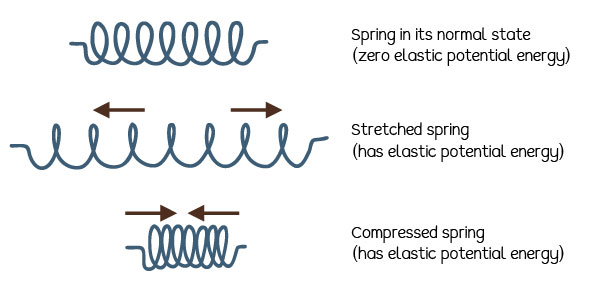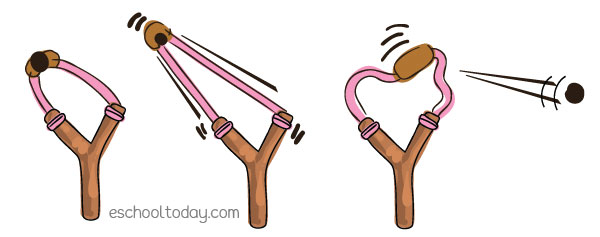- Kinds of energy
What is Elastic Potential Energy?
On the previous page, we learned that potential energy is the energy an object possesses by its height or position (gravitational potential energy) or condition (elastic potential energy). Each time energy is transferred into an object, two things happen. It is either used to do work, or it is stored in the object. If it is stored, the object obtains potential energy that can be released to do work.
Some materials possess elastic potential energy, although some have more than others. Springs, Poly materials such as rubber have more elastic potential energy than wood and metal products. Materials with bending or stretching ability have more elastic potential energy.
What is elastic potential energy?
It is energy stored in stretched or compressed elastic materials. This also means that elastic potential energy is zero in objects that have not been stretched or compressed.

Think of materials such as springs in a jumping trampoline, or strings in an acoustic guitar, or rubber band, bow and arrows, rubber slings, springs, etc, they all stretch or get compressed when we pull or squash them.
Example 1: The Trampoline
A trampoline is a perfect example of elastic potential energy.
Here is a description of what happens when a person jumps on a trampoline.
1. A trampoline is a piece of flexible material held in place by a set of springs. When not in use, the elastic potential energy is almost zero.
2. Assume that a person climbs the trampoline and jumps up. The weight of the person at the height of the jump has gravitational potential energy.
3. By coming down, the gravitational energy is transferred into kinetic energy (energy in a moving object). As the person lands on the trampoline, the kinetic energy in the person forces the springs to stretch. At this point, the kinetic energy is transferred and momentarily stored in the trampoline springs and surface as elastic potential energy.
4. What happens next? Two kinds of work are done here: First, the springs absorb the shock of the person’s landing. Secondly, the elastic potential energy is released back into the person as he jumps up again. The work done is the additional power that the person gets to jump even higher.
Example 2: The Rubber Sling
Another example of stored elastic potential energy is a stretched rubber sling.

1. In the diagram above, when the sling is in its unstretched position, the elastic potential energy is zero.
2. When you stretch the rubber sling, you do work on it. The rubber sling, therefore, acquires energy and is momentarily stored as elastic potential energy. As long as you keep it stretched, the elastic potential energy remains stored.
3. When it is released, the stored elastic energy is transferred into the pebble as kinetic energy.
When the rubber sling returns to its unstretched position, the elastic potential energy is zero.
